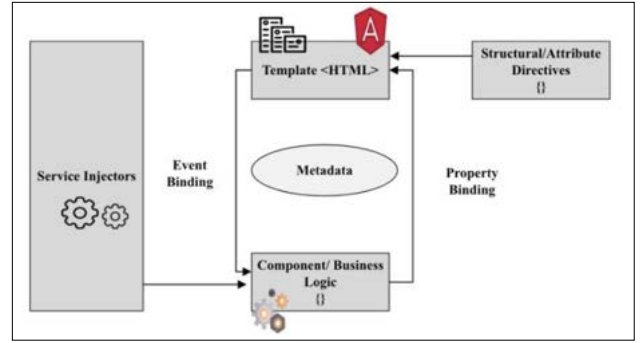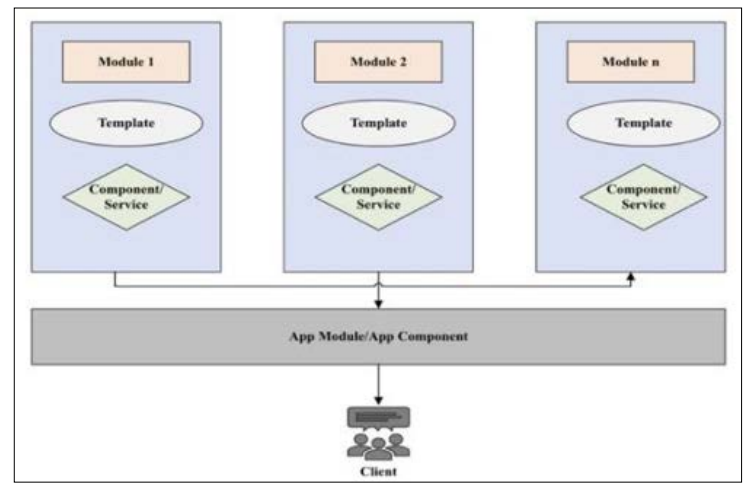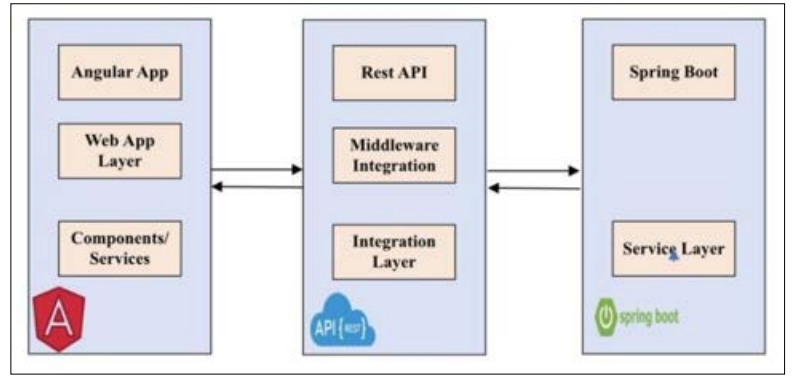Author(s): Phani Sekhar Emmanni
Angular has emerged as a leading framework for building scalable and maintainable enterprise applications. This article delves into the architectural patterns and best practices that harness Angular's robust ecosystem for developing enterprise-level applications that are not only scalable but also efficient and reliable. Through a detailed examination of module-based architectures, microfrontend architectures, and the monorepo approach, we uncover strategies that facilitate the development of large-scale applications, addressing common scalability challenges. Additionally, the article discusses key practices in lazy loading, state management, and component design, aimed at optimizing performance and enhancing the user experience. Security, an imperative aspect of enterprise applications, is addressed by outlining Angular-specific best practices for safeguarding applications against prevalent threats. Automated testing strategies and the role of continuous integration and deployment (CI/CD) in maintaining high-quality codebases are also explored. Drawing on real-world case studies, this article highlights the practical applications and successes of these architectural patterns and best practices, offering insights into overcoming typical challenges faced by developers. By providing a comprehensive guide to scalable application development with Angular, this article aims to equip software architects and developers with the knowledge to leverage Angular effectively in the enterprise domain, fostering innovation and efficiency in web application development.
The scalability and maintainability of enterprise applications significantly determine their success and longevity. As businesses evolve and grow, so too must their software infrastructure, necessitating the adoption of development frameworks and practices that support this scalability. Angular, developed and maintained by Google, stands out as a powerful JavaScript framework for building client-side web and mobile applications [1]. With its rich features and comprehensive ecosystem, Angular offers a solid foundation for developing enterprise-level applications that are scalable, maintainable, and efficient. This article seeks to explore the architectural patterns and best practices that are pivotal when employing Angular in the development of scalable enterprise applications. It delves into the modular nature of Angular, examining how its component-based architecture and development tools can be effectively utilized to build applications that can grow in complexity without compromising on performance or user experience [2]. The core of this exploration revolves around identifying and implementing architectural patterns such as module- based architecture, microfrontend architecture, and the monorepo approach, which have proven effective in large-scale Angular projects [3]. Through a combination of theoretical frameworks, and practical guidelines, this article aims to provide software architects and developers with a comprehensive understanding of how to leverage Angular's capabilities in enterprise application development. It contributes to the body of knowledge by not only highlighting the benefits and challenges associated with Angular but also by offering insights into overcoming common pitfalls in large-scale application development.
Angular, a TypeScript-based open-source web application framework led by the Angular Team at Google and by a community of individuals and corporations, has become a cornerstone for developing robust, efficient, and scalable web applications [4]. Its evolution from AngularJS to its current iteration has seen significant improvements in framework performance, development practices, and application scalability, making it a preferred choice for enterprise-level application development.

Figure 1: Angular Framework
At its core, Angular provides a comprehensive suite of tools and features designed to address the common challenges in developing large-scale web applications. These include a component-based architecture, two-way data binding, modular development, and TypeScript support, which collectively enhance code quality, application structure, and developer productivity [5]. Angular's emphasis on reusability, testability, and maintainability aligns well with the requirements of complex enterprise applications.
One of Angular's key strengths lies in its component-based architecture, which allows for the modular construction of user interfaces. This modularity facilitates the development of large applications by enabling a divide-and-conquer strategy, where different parts of the application can be developed and tested independently before being integrated into a cohesive whole.
Angular's dependency injection system plays a pivotal role in managing the components' creation and providing them with the necessary services, enhancing the framework's flexibility and the scalability of the applications built with it [6].
The introduction of Angular Ivy, the latest rendering engine, marks a significant milestone in Angular's evolution. Ivy offers improved compilation times, smaller bundle sizes, and better debugging capabilities, further elevating Angular's suitability for enterprise applications [7]. The engine's backward compatibility ensures that applications developed with previous versions can benefit from Ivy's advancements without requiring substantial modifications.
Angular's comprehensive ecosystem, which includes tools such as the Angular CLI (Command Line Interface), Angular Material, and a suite of testing utilities, streamlines the development process. The CLI, for example, simplifies project setup, development, and deployment, enabling developers to focus more on building the application's logic rather than on configuring the development environment [8]. Angular Material provides a collection of high-quality UI components based on Material Design, ensuring consistency and usability in the application's user interface [9].
Architectural Patterns for Angular Enterprise Applications Selecting an appropriate architectural pattern is crucial for the success of any enterprise application. For Angular-based applications, certain patterns have emerged as particularly effective in managing the complexities and scalability demands of large-scale projects.
Angular's modular design philosophy encourages the use of Ng Modules to organize an application into cohesive blocks of functionality. A module-based architecture leverages this by dividing the application into a series of feature modules, each encapsulating a distinct set of related functionality. This approach not only facilitates lazy loading to improve initial load times but also enhances code maintainability and reuse [10]. By organizing the application into discrete modules, developers can better manage development efforts across different teams, each focusing on specific application segments.

Figure 2: Module-Based Architecture
The microfrontend architecture extends the concepts of microservices to the frontend, allowing teams to develop, deploy, and scale parts of a web application independently. In Angular, implementing microfrontends can be facilitated through a combination of lazy loading and Angular Elements, enabling the integration of independently developed and deployed frontend components into a cohesive application [11]. This architecture supports organizational scalability by allowing multiple teams to work in parallel on different features of the application without stepping on each other's toes.

Figure 3: Microfrontend Architecture
A monorepo, or a monolithic repository, involves storing all of an organization's code in a single repository. This approach simplifies dependency management, code sharing, and collaborative development across multiple Angular projects [12]. While the monorepo approach can introduce challenges in terms of repository size and build times, tools like Nx have emerged to address these issues, providing powerful capabilities for managing Angular projects in a monorepo setting.

Figure 4: Monorepo Approach
Best Practices for Developing Scalable Angular Applications Developing scalable applications with Angular requires adherence to a set of best practices that ensure the application can grow in features and users without degradation in performance or maintainability.
Lazy loading is a technique where application components, modules, or resources are loaded only as they are needed, rather than at the initial loading of the application. This significantly reduces the initial load time, enhancing the user experience, especially in large-scale applications [13]. Angular supports lazy loading out of the box through its router configuration, making it straightforward to implement this performance optimization technique.
Effective state management is pivotal in developing scalable Angular applications. It ensures that the application's state is predictable, manageable, and scalable. Angular developers have several libraries to choose from, such as NgRx, NgXS, and Akita, each with its own set of principles and practices [14]. The choice of state management strategy should be guided by the application's specific requirements, considering factors such as complexity, team familiarity, and performance considerations.
Designing reusable components is a cornerstone of scalable application development. In Angular, components should be designed to be as independent and reusable as possible, promoting DRY (Don't Repeat Yourself) principles and enhancing application consistency [15]. This involves creating generic, well-documented components that can be utilized across various parts of the application without modification.
Automated Testing, Continuous Integration/Deployment Automated testing, continuous integration (CI), and continuous deployment (CD) are crucial for maintaining the quality and reliability of scalable Angular applications. Automated tests (unit, integration, and end-to-end) ensure that the application functions as expected after changes [16]. CI/CD practices streamline the development process, allowing for faster feedback loops and ensuring that code changes do not break existing functionality.
While Angular is a robust framework for developing enterprise- level applications, several challenges and limitations can arise, particularly when scaling and integrating complex systems. Understanding these hurdles is crucial for developers and architects to effectively navigate and mitigate potential issues.
As Angular applications grow in size and complexity, developers may encounter difficulties in managing codebases, especially when dealing with large teams and modular architectures. This complexity can lead to increased development time, higher maintenance costs, and challenges in implementing consistent coding standards across teams [17].
Performance optimization remains a critical concern for Angular applications, particularly in scenarios involving large datasets, complex UIs, and real-time data processing. Ensuring responsive and efficient applications requires a deep understanding of Angular's change detection mechanisms, rendering processes, and optimization strategies like lazy loading and server-side rendering [18].
Integration with Other Technologies and Legacy Systems Integrating Angular with legacy systems and other technology stacks can present significant challenges, including compatibility issues, data synchronization problems, and the need for custom adapters or middleware [19]. Such integrations often require extensive planning and a strategic approach to ensure smooth operation and minimal disruption to existing workflows.
Effectively managing application state in scalable Angular applications, particularly those adopting microservices architectures, requires careful consideration of state management strategies. Choosing between state management libraries like NgRx, NgXS, or Akita, and ensuring seamless state synchronization across distributed systems, can be challenging [20].
Using Angular for the front-end of CMS platforms, providing content creators and marketers with intuitive interfaces for managing and publishing content, while ensuring scalability and security for enterprise-level usage.
Utilizing Angular for developing secure, reliable online banking and financial services applications, where performance, user experience, and security are paramount.
Angular is ideally suited for building SPAs that offer a fluid, dynamic user experience akin to desktop applications, minimizing page reloads during user interactions.
Leveraging Angular’s modular architecture and robust ecosystem, enterprises can develop large-scale web applications that are easy to maintain and scale.
Angular’s ability to handle dynamic content and interactive UIs makes it an excellent choice for building responsive, user-friendly e-commerce websites.
Customer Relationship Management (CRM) Systems Angular’s responsive design capabilities and integration with databases and APIs make it suitable for developing CRM systems that manage customer data and interactions efficiently.
Angular can be used to build social networking platforms that require real-time updates, interactive user interfaces, and the handling of vast amounts of data and connections.
This article has explored the critical architectural patterns and best practices that underpin the development of scalable enterprise applications using the Angular framework. Through a detailed examination of module-based architectures, microfrontend approaches, and the adoption of monorepos, we have identified key strategies that enable developers to construct robust, maintainable, and scalable applications. Additionally, the discussion on best practices, including lazy loading, state management, and component design, highlights the importance of efficiency and performance optimization in Angular applications.
The integration of Angular with microservices also presents a forward-looking approach to building enterprise applications, addressing the challenges of security, data management, and service discovery through strategic solutions. While these practices lay a strong foundation for enterprise application development, it's crucial to acknowledge the evolving nature of web development technologies. The continuous advancement in Angular and associated technologies necessitates an ongoing reassessment and adaptation of these best practices.
Ultimately, the success of Angular in enterprise applications lies in its robust ecosystem, comprehensive documentation, and the vibrant community that supports it. By leveraging the insights provided in this article, developers and architects can navigate the complexities of large-scale application development more effectively, ensuring that their Angular applications are not only scalable but also poised to meet the demands of modern business environments.
